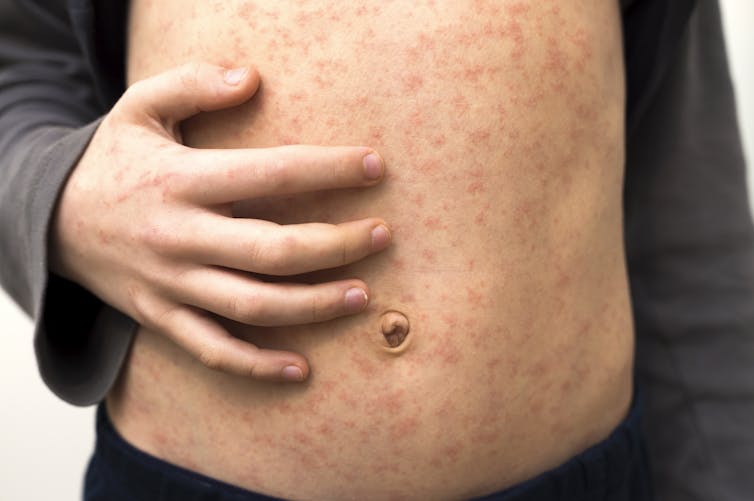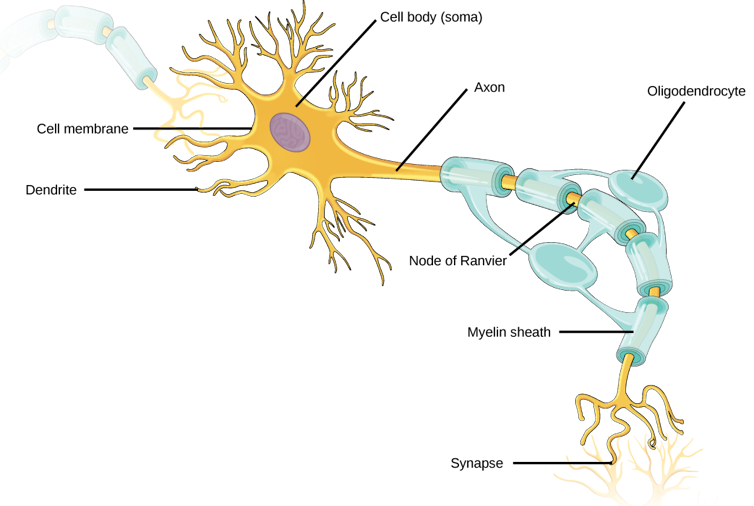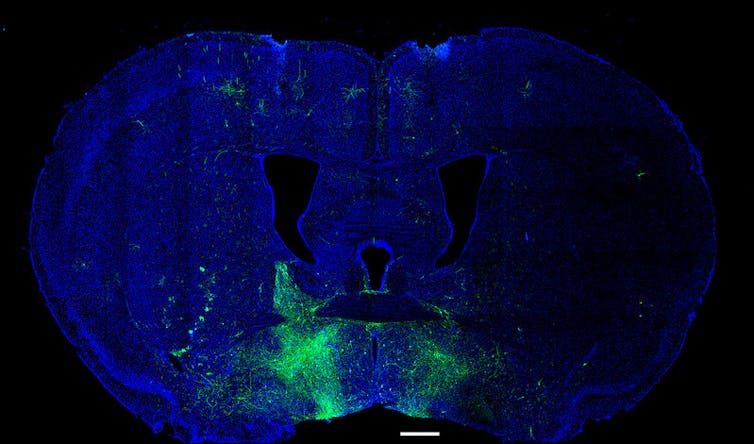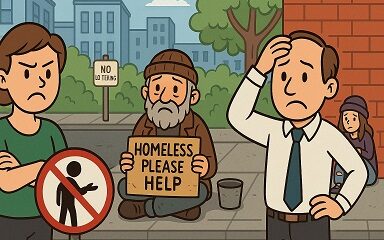
Bilanol via Getty Images
Daniel Pastula, University of Colorado Anschutz Medical Campus
On Feb. 26, 2025, Texas health officials announced the death of a child in a measles outbreak – the first measles death in the United States since 2015. The outbreak was first identified in early February in Gaines County, Texas, where just 82% of kindergartners are vaccinated against measles, compared with 93% on average across the country. As of Feb. 27, there were at least 124 confirmed cases in Texas and nearby towns in New Mexico.
In an interview with The Conversation U.S. associate health editor Alla Katsnelson, neurologist and medical epidemiologist Daniel Pastula explains why measles is so dangerous and how people and communities can protect themselves from the virus.
What is measles, and where does it come from?
Measles is an ancient disease caused by a virus that probably evolved in cattle and jumped into humans around 500 B.C. One of the first written accounts of it comes from a Persian physician named Rhazes in the ninth century C.E., and measles epidemics were described in medieval Europe and western Asia regularly beginning around 1100-1200. The virus got brought over to the Americas in the 1500s, and it wiped out large populations of native people as Europeans colonized the continent.
By the 1950s in the United States, there were 500,000 reported cases of measles each year – though the true number was probably closer to 4 million . It was so contagious, every kid was thought to have gotten measles by age 15. At that time, measles caused close to 50,000 hospitalizations annually and about 500 deaths, usually in children. It also caused over 1,000 cases of severe brain inflammation every year.
The first measles vaccine became available in 1963, and scientists improved it over the following decades, causing the number of cases to plummet. In 2000, measles was declared eliminated from the U.S.
Since then, there have been occasional minor flare-ups, usually brought in by international travelers, but by and large, measles outbreaks have been rare. No one had died of it in the United States in nearly a decade.
Today, measles infections in the U.S. are almost completely preventable with vaccination.

Sergii Iaremenko/Science Photo Library via Getty Images
What are the typical symptoms of measles?
About 10 to 14 days after infection, people suffering from measles experience a very high fever, cold-like symptoms including a runny nose and sneezing, and eye inflammation called conjunctivitis.
Next, they may develop white spots called Koplik spots inside their mouth and a diffuse, spotty, red rash that starts at the head and neck, then descends across the entire body. This rash is where the disease gets its name – the word “measles” is thought to come from a medieval Dutch word for “little blemishes.”
Symptoms of measles infection take about three weeks to resolve. People are contagious from about four days before symptoms emerge to four days after the rash starts.
What are the possible severe outcomes of measles?
Epidemiologists estimate that 1 in 5 people who are infected with measles get sick enough to be hospitalized. About 1 in 10 develop ear infections, some of which may result in permanent deafness.
About 1 in 20 people develop severe measles pneumonia, which causes trouble breathing. Reports from west Texas this month suggest that many infected children there have measles pneumonia.
About 1 in 1,000 people develop severe brain swelling. Both measles pneumonia and brain swelling can be fatal. About 3 in 1,000 people die after contracting measles.
In about 1 in 10,000 who get sick with measles and recover from it, the virus lies dormant in the brain for about a decade. It then can reactivate, causing a severe, progressive dementia called subacute sclerosing panencephalitis, which is fatal within one to three years. There is no treatment or cure for the disease. I have seen a couple of suspected cases of subacute sclerosing panencephalitis, and none of these patients survived, despite our best efforts.
Given how contagious measles is and how severe the outcomes can be, physicians and public health experts are gravely concerned right now.
How does measles spread?
Measles is one of the most contagious infectious diseases on the planet. The virus is so infectious that if you are in a room with an infected person and you are not vaccinated and have never had measles before, you have a 90% chance of becoming infected.
The measles virus is transmitted by droplets released into the air by infected people when they cough, sneeze or simply breathe. Virus particles can survive suspended in the air or on indoor surfaces for up to two hours, so people can get infected by touching a surface carrying virus particles and then touching their face.
Who should get the measles vaccine, and how effective is it?
The vaccine for measles has historically been called the MMR vaccine because it has been bundled with vaccines for two other diseases – mumps and rubella. Most children in the U.S. receive it as a two-dose regimen, which is 97% effective against measles.
Children generally get the first dose of the vaccine at 12-15 months old and the second dose when they are 4-6 years old. Infants who haven’t reached their first birthday generally do not receive it since their immune system is not yet fully developed and they do not develop quite as robust of an immune response. In an emergency, though, babies as young as 6 to 9 months old can be vaccinated. If an infant’s mother previously received the MMR vaccine or had been infected herself as a child, her transferred antibodies probably offer some protection, but this wanes in the months after birth.
People born before 1957 are considered immune without getting the vaccine because measles was so widespread at that time that everyone was presumed to have been infected. However, certain people in this age group, such as some health care workers, may wish to discuss vaccination with their providers. And some people who had the original version of the vaccine in the 1960s may need to get revaccinated, as the original vaccine was not as effective as the later versions.

Based on available evidence, the vaccine is effective for life, so people who received two doses are most likely protected.
A single dose of the vaccine is 93% effective. Most people vaccinated before 1989 got just one dose. That year, an outbreak in vaccinated children with one dose spurred public health officials to begin recommending two doses.
People with certain risk factors who received only one dose, and everyone who has never received a dose, should talk to their health care providers about getting vaccinated. Because the vaccine is a live but weakened version of the virus, those who are severely immunocompromised or are currently pregnant cannot get it.
People who are immunocompromised, which includes those who have chronic conditions such as autoimmune disorders, are undergoing certain cancer treatments or have received an organ transplant, are more susceptible to measles even if they have been vaccinated.
In the current measles epidemic in Texas, the vast majority of people falling ill are unvaccinated. Public health officials there are urging unvaccinated people in affected areas to get vaccinated.
What measures can protect communities from measles outbreaks?
Vaccination is the best way to protect individuals and communities from measles. It’s also the most effective way to curb an ongoing outbreak.
High rates of vaccination are important because of a phenomenon called herd immunity. When people who are vaccinated do not get infected, it essentially stops the spread of the virus, thereby protecting those who are most susceptible to getting sick. When herd immunity wanes, the risk of infection rises for everyone – and especially for the most vulnerable, such as young children and people who are immunocompromised.
Because measles is so contagious, estimates suggest that 95% of the population must be vaccinated to achieve herd immunity. Once vaccine coverage falls below that percentage, outbreaks are possible.
Having robust public health systems also provides protection from outbreaks and limits their spread. Public health workers can detect cases before an outbreak occurs and take preventive steps. During a measles outbreak, they provide updates and information, administer vaccines, track cases and oversee quarantine for people who have been exposed and isolation for people who are contagious.![]()
Daniel Pastula, Professor of Neurology, Medicine (Infectious Diseases), and Epidemiology, University of Colorado Anschutz Medical Campus
This article is republished from The Conversation under a Creative Commons license. Read the original article.






























































